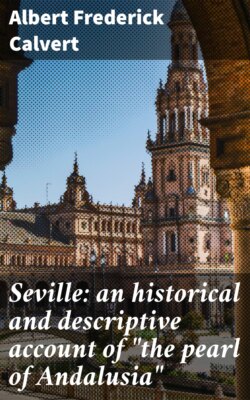Читать книгу Seville: an historical and descriptive account of "the pearl of Andalusia" - Albert Frederick Calvert - Страница 3
ОглавлениеSEVILLE
AN HISTORICAL AND DE-
SCRIPTIVE ACCOUNT OF
“THE PEARL OF ANDALUSIA”
BY ALBERT F. CALVERT
WITH 300 ILLUSTRATIONS
LONDON: JOHN LANE, THE BODLEY HEAD
NEW YORK: JOHN LANE COMPANY MCMVII
TURNBULL AND SPEARS. PRINTERS, EDINBURGH
PREFACE
There is a charm and compelling fascination about Seville which produces in the traveller visiting the city for the first time a sensation of physical ecstasy. The spell of the Pearl of Andalusia is instant and enduring; I have not met a man or woman proof against its witchery. George Borrow shed tears of rapture as he beheld Seville from the Cristina Promenade, and “listened to the thrush and the nightingale piping forth their melodious songs in the woods, and inhaled the breeze laden with the perfume of its thousand orange gardens.” The Moors left their beloved capital at the height of its prosperity, in the full flower of its beauty; change has not affected its material importance, and time has not staled its infinite variety. A Christian Cathedral now stands on the foundation of the great mosque of Abu Yakub Yusuf; but the Moorish Giralda, the most expressive monument of the Mohammedan occupation, still beckons the distant traveller onwards to the promised land; the Alcazar breathes the spirit of its Oriental masters; and the shimmering Torre del Oro still reflects the light of the setting sun upon the broad bosom of the rose-coloured river.
The history of Seville from the time of its subjugation by Musa is a volume of romance; its pages are illumined by the cold light of flashing steel and stained with the blood of tyrants, traitors, and innocent men; but it forms a chronicle which the reader will follow with absorbing interest. The more exacting student will satisfy his thirst for knowledge in Dr Dozy’s “History of the Mohammedans of Spain,” in Gayangos’ translation of El Makkari’s “History of the Mohammedan Dynasties in Spain,” in Coppee’s “History of the Conquest of Spain,” and Pedro de Madrazo’s “Sevilla”—to refer to only a few of the many learned works that have been published on the subject. Many will continue to be content with the few pages of Notes which appear in the various Spanish Guides; but a certain section, it is hoped, of the English travelling public, will find in this book an album, a handbook, and a history which will supply a long-felt want.
In my attempt to produce a volume which will appeal both to the artist and the tourist, to the archæologist as well as the least imaginative sightseer, I have reproduced a number of illustrations which may incline some persons to accuse me of a superabundant regard for detail. It is true that many pages are devoted to intricacies of decoration which the general reader may find of small interest, but my object in multiplying this detail is to satisfy the requirements of those who would fathom the mystery of Moslem art. When I was first in Granada I inquired for pictures of the minutiæ of many choice examples of design, and, failing to obtain anything of the kind, I had to employ a local artist to make sketches of the detail of the mosaics. That experience determined me, in treating of these Mohammedan cities of Spain, to include those reproductions for which I had searched in vain, and to make my illustrations, as far as possible, the last word on the subject of Arabian architecture and ornament.
For the historical portion of the letterpress I have laid under tribute the authorities already mentioned, and I have also to acknowledge the assistance received in the compilation from Mr E. B. d’Auvergne.
A large number of the photographs included here were supplied by Messrs Rafael Garzon and Senan & Gonzalez of Granada, Hauser & Menet of Madrid, Ernst Wasmuth of Berlin, publisher of Uhde’s “Baudenkmaeler in Spanien und Portugal,” and Eugen Twietmayer of Leipzig, publisher of Junghandel’s “Die Baukunst Spaniens,” and my thanks are due to them for the courteous permission to reproduce their work in this volume.
Some of the illustrations are reproductions of pictures which were at one time in the San Telmo Collection. As that collection has been distributed I have been unable to trace the originals, but as they were so closely identified with Seville I make no apology for including them.
A. F. C.
“Royston,”
Swiss Cottage,
N.W.
